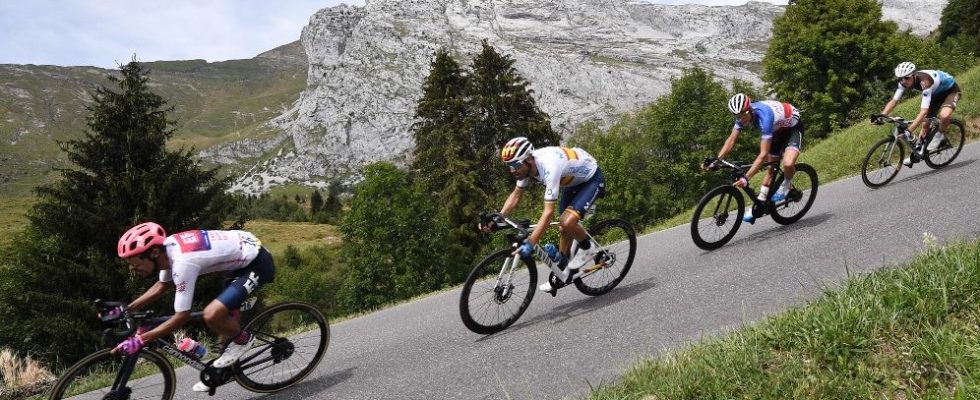The first mountain stage of the 110th Tour de France will take the peloton from Pau to Laruns on Wednesday. With it, the Col de Soudet (out of category), Marie Blanque (1st category) and their vertiginous descents, which will necessarily bring back the painful memory of the accident of Gino Mäder, who died on June 16. Thibaut Pinot “thinks about it almost every time he goes down in training”, even if he was not present on the Tour de Suisse. “People don’t realize what you’re doing on a bike at 100 km/h. We very quickly forget the risks we take, ”he slipped to AFP. The tragedy had the merit of (re)putting the subject of security on the table, and pushing all the players concerned to question themselves.
In tightrope walker mode
Part of the peloton felt the need for psychological support following the death of the climber from the Bahrain-Victorious formation. At Arkéa-Samsic, the competition program of a runner, a young father, “has been adjusted to allow him to find his bearings on what seems to him safe “says Théo Ouvrard, sports manager of the Breton team. “We know that the slightest hole or gravel can have consequences, continues Vincent Lavenu, manager of AG2R-Citroën. The runner who thinks about it in the race is no longer in the capacity to fight. It is necessary to respect, to remember, but in the competition, the runner must, with a certain measure, launch into the descent and try to be fair in his analysis. »
The descents have indeed become a real performance issue, a terrain where the difference is likely to be made. A striking example: the number of Tom Pidcock last summer, ball in mind in the descent of Galibier. Almost at breakneck speed, as the saying goes, the Briton flirted with 100 km/h, before winning at the top of Alpe d’Huez. “I am divided, slips Théo Ouvrard. It’s clean, it’s beautiful, but it sometimes gives cold sweats. “The sequence, which Netflix has not failed to resume, however confirms that having a good descent has become essential in the cycling of the 2020s. “It is no longer possible to be professional when you do not descend well, according to Ouvrard. The level is really very high among professionals. A good descender ten years ago would be a normal descender today. »
“Five years ago, it was very rare. We said to the runners: “You are not going down well, that’s how it is, we’ll deal with it.” Now we are trying to work on it. In July, we will bring in mountain biker Stéphane Tempier, who is used to training young riders in downhill. The way to approach the descents has changed with the evolution of speeds and technology. The technical level rises. With disc brakes, you can gain more speed between braking. » More speed, and therefore less latitude to react in the event of an incident.
A new commission, terminals and mattresses
On June 30, the various players in the cycling world officially gave birth to SafeR, an independent organization responsible for strengthening the safety of races. In his press release, the president of the International Cycling Union (UCI), David Lappartient, deplored that “the number of incidents and injuries continues to increase”, pointing to “the rapid expansion of road furniture” and “increasing the speed of the peloton”. The entity will analyze the risks relating to the routes, provide advice and carry out audits of the organizers and the teams.
The downhill file will obviously be on the table. “For the most part, they are known to the riders, they know if they are dangerous or not, if there are one or two delicate turns. It is mentioned during the briefings. We show the way, we evoke the most complicated curves,” says Théo Ouvrard. To go further, the president of the riders’ union (CPA), Adam Hansen, announced several measures for stages 14 and 17 of this Tour de France, in particular the installation of bollards with audible warnings upstream of certain turns.
In the descent of the Col de la Loze, ditches will also be blocked, and inflatable mattresses installed over several tens of meters. The president of the syndicate will himself recognize the descents of these two stages by bike to film them and send the images to the teams. Pinot, on the other hand, imagined protective nets, “as we do in skiing”, to reduce the risks. Others were downright fired at these downhill finishes, like world champion Remco Evenepoel.
After the fall of Mäder, the Belgian dropped: “A finish at the top would have been perfectly possible. It wasn’t smart to place the finish of such a stage after a descent. But apparently, we always need more spectacle. » Beyond the necessary diversity of routes, downhill finishes are sometimes preferred for logistical reasons (installing a finish area at the top of a pass is not always easy) and economic (the stopover towns pay to accommodate a departure or arrival).
“It remains an integral part of our sport, we cannot do without the descents, explains Warren Barguil. I saw an evolution compared to my beginnings pro. Many more means are put in place for our safety. The organizers are very careful and we have more and more of our say with the riders’ union. “Zero risk will never exist, but the world of cycling is committed to getting closer to it.

